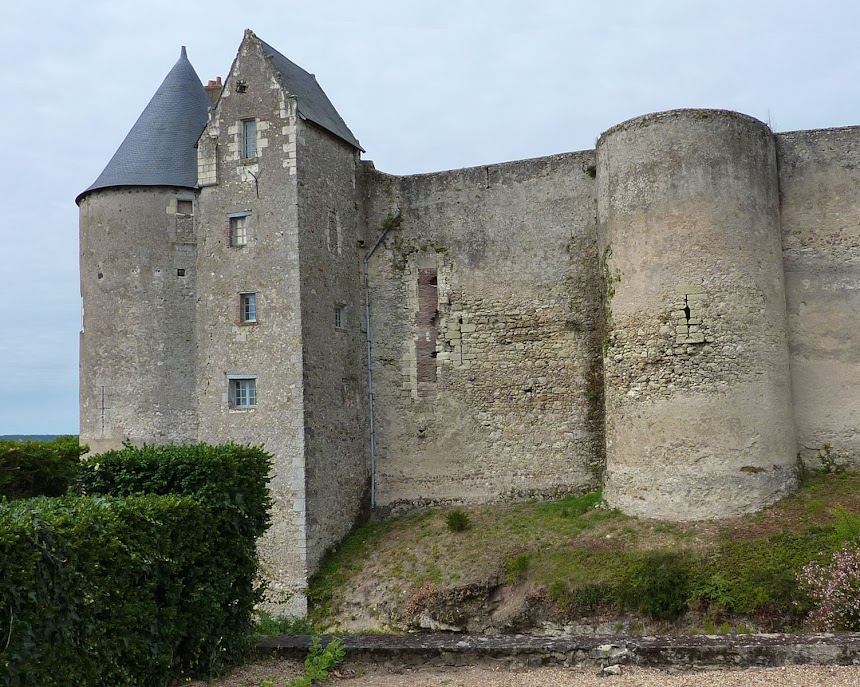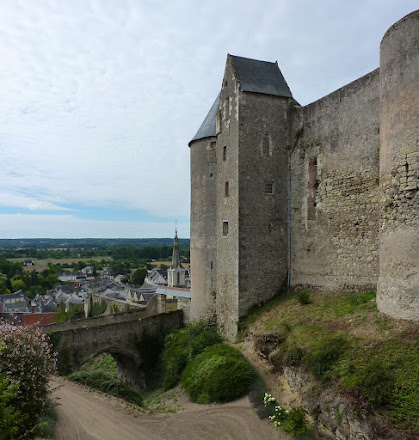Before the town of Luynes was given that name in the 17th century, it was known as Maillé. The founder of the place was a Gallo-Roman figure named Malliacum. By the Middle Ages the name of his descendants and the town had evolved phonetically to become Maillé. Luynes is a village in Provence, and the man who would become the duke of Luynes came from there. He was a childhood friend of the French king Louis XIII, who reigned from 1610 until 1643, with his mother Marie de Médecis as regent early on. King Louis and the duke — he was made a duke and a peer of the realm by Louis in 1619 — were said to be hunting and falconry buddies. Luynes became the king's most powerful minister; his successor would be Richelieu.


The Château de Luynes stands atop a rock spur, with the town below. The imposing towers date back to the 13th century.
Nowadays, the dry moat around the château has been turned into a garden.
 In the 15th cerntury, when the forbidding medieval fortress was still owned by the Maillé family, window openings
In the 15th cerntury, when the forbidding medieval fortress was still owned by the Maillé family, window openingswere cut in the tower walls. Windows brought a lot more light into the austere gray buildings.


The Château de Luynes is still owned and occupied by the descendants of the first duke of Luynes.
It was only opened to the public in the 1990s.

Unfortunately, I couldn’t take photos of the chateau because when I fell, I dropped my Lumix which hit a stone blocking the shutter!
ReplyDeleteFortunately, you knew how to fix it when we were back at Les Bouleaux.
Was it the lens cover? It wouldn't open when you turned the camera on? Am I remembering correctly?
DeleteYes, I think you’re right.
DeleteWow. That is certainly an imposing place.
ReplyDeleteI love this chateau, especially the garden in the moat idea.
ReplyDeleteGlad you were able to fix CHM's camera. The weather looks perfect for sight seeing. The first two photos are stunning.
ReplyDeleteInteresting history of the chateau and its' owners. I wonder if that moat was filled with water or dry?
ReplyDeleteHi, D. Since the chateau sits on a bluff, it was a dry moat. There would have been no way to keep the moat filled with water. Any news?
DeleteThe full name of these people is d’Albert de Luynes. Their ancestor was a Florence nobleman by the name of Alberti. He came to France and bought the “comté” of Luynes, south-west of Aix-en Provence, and became d’Albert de Luynes. Then, he bought the town of Maillé near Tours and changed its name to Luynes. Some other duke, through marriage, became involved in Picardy and gave his name, Albert, to a town there not far from the craddle of my paternal family.
DeleteThe history of the duke and duchy de Luynes is very complicated. Sources seem to differ greatly on the details of the story. Charles d'Albert was the first duke of Luynes. Despite sources saying that Charles d'Albert was a childhood friend of Louis XIII, others say Charles d'Albert was more than 20 years older than Louis XIII. Charles d'Albert died at the age of 43 from scarlet fever, after having been granted control over the town in Picardy that would come to be called Albert. Trying to understand it all makes my head spin. The village of Luynes in Provence, is just four or five kilometers from Aix-en-Provence. It has a population of nearly 5,000 but is not a commune but a quartier that is part of the commune d'Aix-en-Provence.
DeleteThank you for these precisions.
Delete